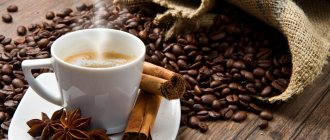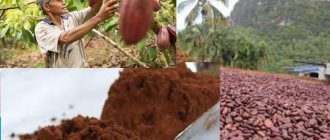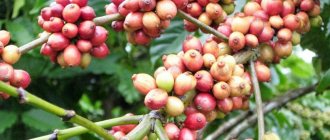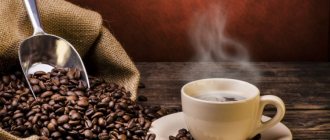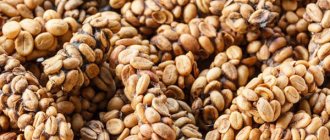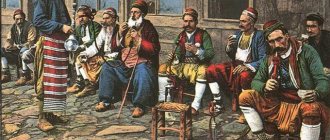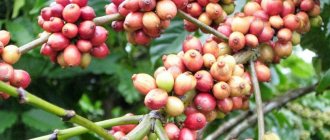Vietnamese Coffee
It is very popular among its connoisseurs due to its special refined aroma and richness of taste. This is the description that best characterizes the local aromatic drink. There are several main factors that contribute to this.
- Unique climate. Initially, French colonialists noticed this in the 19th century and began to cultivate a plant new to the region. The first coffee plantations appeared in the south of the country in Nghe An province. A little later, a Swiss scientist discovered an ideal place due to its geographical location in the mountains near Dalat, the capital of Lam Dong province. Life-giving moisture and the bright sun of the subequatorial zone enrich the grains with useful substances and allow them to be saturated with this extraordinary aroma.
- Traditional national method of roasting. Resourceful Vietnamese use different technologies. But the main one is the addition of cocoa beans. They are the ones who give the magical taste of chocolate that cannot be confused with any other.
Types of coffee in Vietnam
Cà phê coffee is written in Vietnamese . If there is a prefix đá , it means coffee with ice. In the south of Vietnam, coffee is usually served in tall glass glasses with a straw and ice; you can rarely find coffee without ice. You can ask without ice if you are squeamish and afraid for your stomach (since ice is usually crushed right on the asphalt), but it is unlikely that anyone will understand you. In the north of the country they can serve it without ice.
Cà phê and tea
The taste of coffee is very velvety, soft, like melted chocolate. We prefer to drink coffee before the ice melts.
Coffee with milk cà phê sữa in the south , and cà phê nâu . Despite the name, it is not milk that is added to coffee, but condensed milk. I don’t even know what tastes better—coffee with milk or regular coffee. Coffee with condensed milk is sweeter and is also served with ice in glass glasses. Green tea is often served with it.
Another popular type of coffee (usually in the north) is egg coffee . We came across different names: cà phê trung, cà phê giảng, in general, egg coffee. Served either hot or cold. Hot coffee is brought in a miniature ceramic cup, which is placed in a large bowl of hot water. Iced coffee is served in a glass glass with ice. Both should not be mixed - you must first eat the beaten egg with a spoon and then drink the coffee. The beaten egg has a creamy consistency and is very tender and resembles creme brulee. Stunningly delicious! We liked the hot egg coffee better.
Egg Coffee - cold&hot
You can read about other drinks in our review “Drinks in Vietnam“ .
Where did the Vietnamese get this wonderful drink?
French colonization brought more than just wars and misfortunes to Vietnam. Catholic missionaries, who appeared in large numbers in the early years of colonization, brought coffee beans here. The history of coffee in Vietnam dates back to 1857.
Very quickly, Vietnamese coffee entered the international market and by the middle of the 20th century it had won second place in the world in terms of supply. With the outbreak of the war with the Americans, its production fell sharply and then began to rise again only in the 80s of the last century. Today, coffee plantations cover 503 thousand square meters. km of fertile land in mountainous areas, where up to 2.5 tons of grains are collected from 1 hectare.
Grain collection is carried out all year round. In 1996, Vietnam regained its honorable second place in the world coffee market; in 2001, it joined the International Coffee Organization, which forced the government to strengthen quality control of the exported product. In 2012, Vietnam moved up to 1st place, ahead of Brazil.
Today, almost all plantations are in private hands, the state share in the total volume is no more than 10%.
Interesting facts about Chon Luwak coffee
- The global production of fermented coffee per year is 290 kg.
- It is believed that the best drink comes from the farm where there are more male musangs, because... they produce more of the odorous substance civet than female animals.
- Luwakis are omnivores. In nature, they feed on insects, berries, bird eggs and even small birds and animals. In order to produce the best coffee, they must have a varied diet.
In Asian countries, Chon coffee is something familiar, but for others it is exotic. Whether it is worth trying the Luwak drink, everyone decides for themselves; it all depends on financial capabilities and feelings of disgust.
Vietnamese coffee provinces
The first plantations were planted in the south, in Nghe An province in the late 80s of the 19th century. Later, Swiss microbiologist and researcher Alexandre Yersin discovered the ideal climate for coffee in the highlands around Da Lat, the capital of Lam Dong province.
By the beginning of the 20th century, coffee plantations occupied most of the Tay Nguyen plateau in Central Vietnam, which, in particular, included Lam Dong province.
But the capital of coffee in Vietnam is the Dak Lak province, located there. In its center is the city of Buon Ma Thuot. There is a coffee exchange here.
Vietnamese coffee varieties
Vietnamese coffee is supplied to the market in beans (80% of them are green), ground and instant. The latter are represented not only by pure varieties - Robusta and Arabica, but also by blends.
Robusta
- Robusta (Coffea Canephora) is the most popular because of its simplicity and low cost of production. Has high productivity at minimal cost. Disease resistant and grows at low altitudes. The strongest and most dense drink. It compares favorably with its African and Asian counterparts in its milder taste and lack of sourness, which is usually inherent in this type.
It is called the “Sun of Vietnam”. They are grown at an altitude of 500-1000 m above sea level. The trees are unpretentious, resistant to temperature changes and pests. The only thing they need is plenty of moisture.
Robusta means “healthy” in English. The beans contain a lot of caffeine and biologically active acids, which means the drink invigorates and gives strength. This coffee from Vietnam has a strong tonic effect. It is consumed in the first half of the day to wake up and get ready for productive work.
Vietnamese Robusta grows mainly in the north of the country. The ideal climate, abundant rain and absence of low temperatures, makes it possible to obtain up to 12 harvests per year from one plantation.
The raw materials are not subjected to chemical treatments, which means the grains are completely natural. By the way, the Republic of Vietnam is skeptical about the use of various fertilizers. It is believed that raw materials only need sunlight and moisture, and artificial additives will only spoil them.
Robusta from Vietnam is richly bitter with a distinct earthy or nutty aftertaste. The variety is acid-free.
Arabica
- Arabica (Coffea Arabica) is not the most common type in Vietnam. Arabica plantations occupy only 10% of the total. It is very whimsical and instantly reacts to changes and worsening climatic conditions by reducing the yield.
Arabica is grown in the center and northwest of Vietnam. Main regions:
- Dalat;
- Shonla;
- Dien Bien;
- Quang Tri.
Luwak (Chon)
- Luwak (Chon) is truly exclusive. Paradoxically, the most expensive coffee in the world comes from a poor country in Southeast Asia. The technology for obtaining it intrigues the minds of gourmets. The diet of the palm marten (musanga) includes the fruits of the coffee tree. During the fermentation process, the shell disintegrates, and the grains are saturated with useful substances and acquire inimitable taste. And only after that they are collected, washed from excrement and dried.
What's special about it? The second common name for this type of coffee is Kopi Luwak. It is considered one of the most valuable and unique in the world. And every coffee lover has heard about this drink, even if he hasn’t tried it yet.
Admiring gourmets say: elite, premium, with a soft, unique taste, with notes of caramel, with a subtle aroma of chocolate and vanilla, and finally, the most expensive in the world...
One cup of this coffee in a Dalat cafe, for example, costs about 700 rubles. How can you not want to taste it! But first I would like to know what this “elite beast” is. And yes, further our story will go mainly about animals. More precisely, about small furry animals. “What does coffee have to do with it?” - you ask.
Yes, it’s true, it’s hard to imagine that animals can do it. But this is true. However, this could not have happened without the help of specially trained people.
“Elite beast”, or the Main secret of the famous Musang variety - the producers of the famous coffee So, meet the wonderful animal with the unusual names Musang, civet or palm marten.
It is in this animal and in the unusual production technology, and not in the type of coffee beans, that the main secret and uniqueness of the famous Luwak lies.
Amazing civets eat berries from coffee plantations. But only their pulp is digested, and the grains come out naturally along with the droppings.
And specially trained personnel carefully collect, wash and dry the raw materials to create an exclusive drink. But we hasten to assure you that excrement does not affect the coffee beans themselves.
There is no unpleasant smell, but exactly the opposite. Otherwise, who would drink this, and at an elite price too?! The main value of these Vietnamese animals is that coffee beans undergo special fermentation in their stomach. And the bitterness that is characteristic of grains disappears from them.
That is why the famous Vietnamese Luwak coffee has such a delicate and unique taste.
The technology for preparing Luwak coffee differs from the usual brewing method. In order for the drink to be the most aromatic and tasty, you need to use only freshly ground coffee.
- In Vietnam, coffee is never prepared in Turks or coffee pots.
- Coffee is poured into a special filter.
- Pour boiling water over it.
- Then they place the cup and wait for the drink to slowly collect in it, dripping one drop at a time.
How is Luwak coffee made today?
Nowadays, producing exclusive coffee from animal feces is difficult and expensive. The cost of Luwak coffee, which is collected in the wild, is the highest. Searching for and collecting grains under these conditions is very difficult. Therefore, entire farms have appeared in Vietnam, where they specially breed animals and give them plenty of ripe coffee berries to eat. However, this process also requires significant financial costs, as well as hard farm labor. All raw materials that emerge from the animal’s digestive tract are collected by hand, and then each grain is carefully washed and only then dried.
Excel
- Excelsa (Coffea Excelsa) is a very rare variety. The tree has a large crown and is very sensitive to weather fluctuations. Because of this, it bears fruit quite irregularly. This is the fundamental reason that you cannot find it in its pure form. Most often used by the local population to prepare blends, in which it significantly changes the flavor palette.
Another name is “High Coffee”. Rare premium variety. Trees reach a height of 20 m. They are demanding on the composition of the soil. The harvest literally depends on chance. It is impossible to predict whether there will be fruiting this year or not.
The fruits are shaped like Arabica - fragrant and large. Excelsa has a rich, bright taste. It is not consumed as a separate product, but is added to elite coffee blends to obtain an additional aftertaste.
Coolie
- Kuli is a high-quality premium coffee. One of the most expensive and elite varieties. Coolies are produced in very limited quantities and only in one place - Dak Lak. Has a long aftertaste.
A hybrid of Arabica and Robusta is called Kuli. In Vietnam, it is grown in limited quantities and only in the Dak Lak province.
The variety has a beneficial effect on the body:
- activates brain function and mental activity;
- reduces the likelihood of developing diabetes;
- speeds up the functioning of the gastrointestinal tract;
- invigorates, relieves fatigue.
Kuli has a bitter, rich taste, intense aroma and a long aftertaste. Traditionally, it is drunk “diluted” - with milk or ice.
Blends
The Vietnamese mix varieties in proportions slightly different from traditional (European) ones. Typically blends contain 60% Robusta and 40% Arabica. There is a ratio of 70/30. This is why Vietnamese coffee is a strong drink.
In tourist places you can find blends with Luwak coffee on sale. Most often there is no smell of this expensive variety in the mixture. Under the guise of an elite variety, they may sell you a mixture of Robusta and Arabica.
Chon coffee added to the blend makes it very expensive. By the way, where real Chon is sold, it will never be called “luwak”.
Moka Cheon from Phuong Vy – taste and aroma
This bright summer novelty from the Vietnamese brand Phuong Vy caught our attention more than others from this colorful series. Let us remind you that not long ago we announced as many as 6 new items of Phuong Vy coffee in creative and bright packaging, they can be viewed at this link. But now let's focus only on Moka Chon ground coffee, and more precisely on its taste palette and its play of shades depending on the preparation method.
Moka Chon in the geyser
Coffee prepared in this way is very dense and has a rich taste. And what a aroma! Sweet, chocolate, with light fruity and caramel notes. There is also something very warm and woody in the aroma. Very original! ⠀ Let's try it. From the first sips you can feel the multi-faceted and rich taste; bitterness, by the way, is present, but moderate. The aftertaste is chocolate, there are also hints of tobacco and a distinct sweetness on the residue.
Moka Chung in Fin
In fine Moka Chon it turns out to be less dense in consistency and color.
However, the taste remains rich and bright. By the way, cooked in fin, it is very pleasant to drink in its pure form without sugar and cream. The aroma remains identical to the geyser, but the taste is sweeter and has a very mild tartness. ⠀ Definitely, this coffee will be appreciated by fans of chon coffee and luwak coffee. This is a great option for those who are just getting acquainted with traditional Vietnamese coffee! It has a harmonious taste and aroma without the predominance of bright mono flavors. And also a bright and interesting packaging with a tasting valve, which allows you to maintain the required level of humidity, as well as to feel the aroma of jeon coffee for everyone who wants to get acquainted with it. ⠀ As it cools, it turns out to have a chocolate taste with woody tobacco notes. If you like the tart, chocolate taste, then try Moka Chon Phuong Vy coffee cold. You can buy Moka Chon Phuong Vy coffee with 10% cashback and free delivery on our website. You can view the entire range of Chon coffee and Luwak coffee at this link.
We wish you delicious and bright moments! Your VietVam team
Coffee production and sales companies
There are three companies producing and selling coffee in the Asian republic:
- TrungNguyen. The company has been on the market for about 18 years. The main advantages of Me trang coffee: Regular improvement in product quality. Modernization of production processes. Expanding your own image. Improvement of employee qualifications. Competent use of innovative technologies. Blue Ocean coffee beans One of the best products from this company is Ocean blue.
- HungPhatCompanyLtd. The product grows on the Dalat plateau. The altitude above sea level is 1.5 thousand meters. The climate of this place is ideal for growing brands such as Arabica coffee. Coffee with hazelnut oil "Con Soc". The company's products are synonymous with the phrase “quality mark”. She received recognition in Russia, China, and Japan. Robusta coffee is also produced. Company employees advise brewing the drink using special paper filters.
- Tam Chau Tea and Coffee Company Ltd. The company produces, processes and exports coffee throughout the world. Today, residents of many Asian countries enjoy it, including Japan and Singapore. Ground coffee “Napoleon Bonaparte” Trung Nguyen The following types of beans are used in coffee products: Arabica; Chari; Robusta. The best products from this manufacturer are Napoleon Bonaparte and G7 ground coffee.
The Vietnamese sell grains “for themselves” and “for tourists.” They don't differ in quality, it's all about the price. Products for foreigners are brought to the most famous tourist areas, and they cost more.
In specialized stores, tourists are often offered to taste the products. Traditional packaging of grains – 100, 250 and 500 g.
Prices:
- For a pack of Robusta weighing 250 g in the supermarket you will pay about $2.
- Ground Arabica will cost more, up to $15 for the same pack, and finding it in its pure form is problematic.
- 500 g of blend of Robusta and Arabica – $5-7.
- Luwak is produced on the farm. A product from the wild is much more valuable, but it is impossible to find. It is sold at auctions. Farm Luwakiz bought in Vietnam will cost you $300-400 per kg.
How to save money on coffee in Vietnam
In order not to spend a lot of money and time on coffee every morning, Alyosha figured out how to save on it.
In almost any large store in Vietnam (not a “village” store, but a real supermarket) you can find shelves with coffee, where, along with grain and ground coffee, coffee is sold in 500 ml bottles. This is already pre-brewed and poured Trung Nguyên coffee. It's called Càphê Tươi, which translates as “fresh coffee.”
Don't be alarmed, coffee in bottles does not lose its taste at all. All street vendors do this: they brew their coffee in advance and pour it into one and a half liter bottles, which they then put in a portable refrigerator. Coffee is poured from them when a visitor arrives.
This is what Trung Nguyên coffee bottles look like
Having stumbled upon Càphê Tươi, Lyosha quickly calculated that this method was much more convenient and, most importantly, more economical. Simple arithmetic: a 500 ml bottle costs a maximum of 34 thousand dong (sometimes 30 thousand on promotion) and holds 12 cups of coffee of 40 ml each. If you take the average cost of coffee in a decent cafe for 12 thousand dong, then you can save about 110 thousand dong. One cup of coffee costs us about 3 thousand dong (2.8 thousand) instead of 12 thousand.
Since then, we don’t go to cafes, but buy just this kind of coffee. Instead of ice, we dilute it with cold water and also add sugar or condensed milk.
If you have a coffee filter and a stovetop (or a small travel electric kettle like ours), you can save money on coffee by making your own. By the way, condensed milk costs about 13 thousand dong.
Roasting method
The smell and slightly chocolatey taste are the “trademark” of Vietnamese coffee. This is how it is fried only here. Once you try it or simply feel this magical aroma, you will never forget it and will not confuse it with anything else.
Coffee beans are roasted with cocoa beans. The resourceful Vietnamese have many roasting methods, but this is the basic one. The chocolate flavor can be combined with caramel. This means that the grains were roasted with the addition of fruit syrups.

